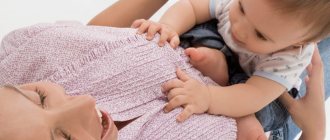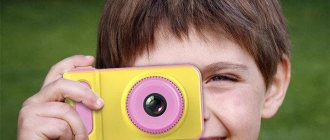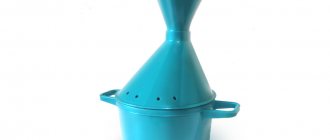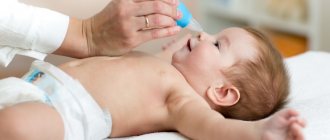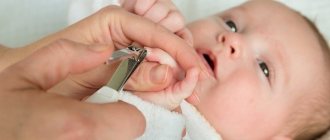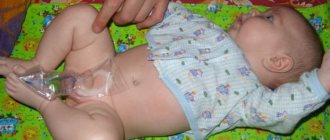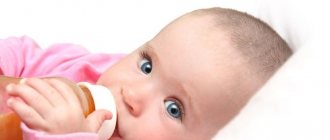Saline solution for rinsing the nose of a newborn should be in every mother's medicine cabinet, especially if the house is hot and stuffy. It will help moisturize the mucous membranes, which is necessary to protect against infectious diseases. If a child gets sick, it is useful for parents to know how to properly rinse their baby’s nose with saline. Wrong actions can lead to complications, and the baby’s breathing will not only not be restored, but also, for example, otitis media will occur.
Baby
What is saline solution?
The drug is made based on sodium chloride and water.
The substance is called physiological because its basic chemical and physical properties coincide as closely as possible with the parameters of human blood plasma. This product is the simplest isotonic solution. Many doctors advise using saline solution to rinse the nose at home. It helps cope with rhinitis and sinusitis. The drug is absolutely safe, and therefore can be used for the treatment of children and pregnant women.
Saline solution can be bought at any pharmacy. The simplest and most affordable option is glass bottles, which are closed with a rubber stopper and metal foil. Their capacity can be 100, 200 or 400 ml.
To use the solution, the foil can be removed and the cap opened. However, you can use saline solution for no more than 1-2 days. The solution will then become non-sterile. To preserve the characteristics of the medicine, you need to open a small metal cap and draw the substance with a syringe.
For more convenient use, you can purchase the substance in small ampoules, which should be used at a time. However, it is important to take into account that if such a container is opened carelessly, there is a risk of glass fragments getting into the liquid.
You can also find more convenient products on sale, which are made on the basis of saline solution and are equipped with special attachments for the nose. This category includes any substances based on sea water or ordinary salt, having a concentration of 0.9%:
- aqualor;
- aquamaris;
- quickx;
- salin;
- physiometer.
Organization of inhalations for rhinitis
Saline solution is often used to moisten the airways and clear accumulated phlegm and mucus. If sodium chloride is diluted with another medicine during inhalation, the proportions must be strictly observed. In this regard, this should be done by a specialist. Information about the ratio is always indicated in the annotation.
The finished medicine can be stored in the refrigerator for 24 hours. Before using the inhaler, it is warmed to room temperature.
If several drugs are prescribed at once, it is important to follow the sequence established by the doctor
Inhalations with saline solution without impurities are carried out both for treatment and as prevention. You should not abuse this method, because the body gets used to it and stops responding correctly to treatment.
Let's start washing the newborn's nose:
- Pre-clean your baby's sinuses using an aspirator; you can also do this with cotton wool soaked in a rinsing solution. Then the solution will fit better into the spout.
- Lay the newborn on his side, and gradually pour in the solution from a syringe or aspirator until it begins to flow out of the nose on its own. Along with the solution, unnecessary mucus will come out of the nose.
The most favorable time for the procedure is after
A runny nose often plagues people, but children especially often suffer from it. Irrigation therapy is considered one of the safest and most effective remedies for it.
, but a reasonable question immediately arises: how to rinse a child’s nose so that the procedure only brings benefits.
After all, incorrect execution of actions can harm the baby’s health and provoke the development of complications.
It is recommended to stay at home for another hour and monitor the baby’s well-being. All manipulations must be performed extremely carefully so as not to damage the mucous membranes. Before rinsing, obtain the doctor's approval and his recommendations. A mixture prepared at home is not suitable for rinsing the nose of an infant, since it is not sterile.. The main advantage of rinsing an infant with a solution of sodium chloride 0.9% is the simplicity of the procedure
Which type to choose
Based on symptoms, we recommend:
- During viral epidemics, when the air in the room is not humid enough, during seasonal allergies, use Aqualor Soft.
- Before carrying out manipulations, Aqualor Norm is needed to effectively free the nasal cavity from infected accumulations.
- The nose is very stuffy, there is a large accumulation of pus, the maxillary sinuses are clogged. Aqualor Forte will help relieve swelling and clear the nasal cavity of mucus.
- Purulent processes in the nose and swelling will help relieve Aqualor Extra Forte with natural ingredients. The main condition is the absence of allergies to the constituent ingredients.
- Aqualor Baby isotonic solution is optimal for caring for the nose and treating a runny nose in a child with a viral nature.
We recommend reading: How to remove excess mucus from the body? Here are the best ways!
For what type of runny nose the drug is intended is indicated in the instructions for use.
Indications for use
Key indications for the use of saline include diseases of the respiratory system:
- acute respiratory viral infections;
- drug-induced rhinitis;
- vasomotor rhinitis;
- sinusitis;
- allergic rhinitis;
- fungal infections of the upper respiratory tract.
Also, an indication for the use of saline solution at home is prevention in the midst of epidemics and a seasonal increase in the incidence of ARVI. In addition, the substance is used to moisturize the nasal cavity when the air in the room is very dry.
Treatment of a runny nose
The solution allows you to quickly cure acute rhinitis (runny nose), reduce the need for the use of other medications (for example, antibiotics). With timely treatment of the nasal cavity, the disease can be reduced to two to three days.
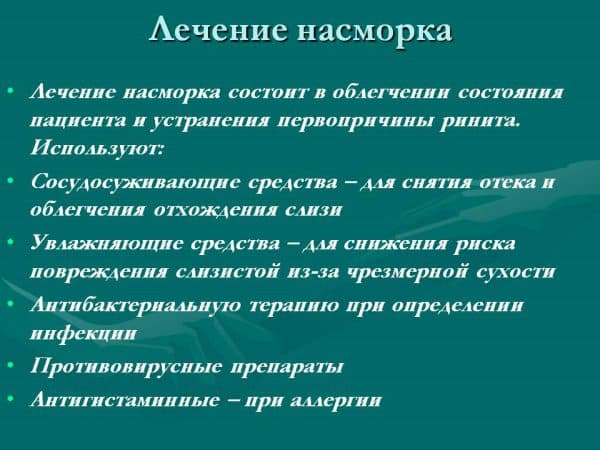
Efficacy for sinusitis
For a disease such as purulent sinusitis, saline solution is recommended as a medicine for washing pus from the sinuses and nasal appendages. Thanks to the procedure, you can prevent and stop the spread of germs. Irrigation should be carried out every hour. It is also recommended to alternate means when washing (for the first time - saline solution, then - with a liquid that contains herbal preparations).
For sinusitis, rinsing the nose with saline is an additional measure. It is not an independent operation; it is used in combination.
Rinse throat
For throat diseases, the solution is also used. Moreover, it is used in pharmaceutical concentration. There is no need to dilute it with water. You need to gargle at least twice a day. In a situation where the disease occurs with complications, it is necessary to treat the throat at least five times a day. In this case, you need to combine it with the use of other antiseptic solutions. It is recommended to irrigate not only the throat, but also the nose. For inflamed tonsils, it is recommended not to rinse, but to organize absolute rinsing (the liquid passes through the nose into the mouth).
How to properly rinse a baby's nose?
The position you choose to wash your baby's nose depends on his skills. If the baby is already confidently holding his head, the procedure is performed when the child is in an upright position with his head slightly tilted forward. It is convenient if one adult presses it to his chest, tilting his head to his shoulder, and the second rinses the spout. Tilt of the head is necessary as a protective measure to prevent water from entering the middle ear and causing inflammation.
If the baby is still lying down, he must be turned on his side, and all manipulations are performed in this position. In this case, it is desirable that the baby’s mouth is open - so he can breathe calmly.
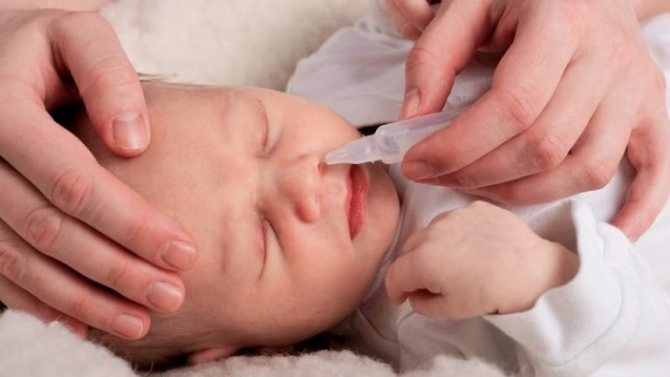
To administer saline solution, use a rubber syringe, a small syringe or a pipette. You will also need flagella twisted from cotton wool and sea buckthorn or peach oil.
How to clean your child's nose:
- If there is congestion, use a syringe to suck out the mucus
- Instill 1-2 drops of saline solution into each nostril using a pipette or syringe.
- Use cotton wool to remove crusts and mucus from the nose.
- The mucous membrane is lubricated with sea buckthorn or peach oil - this makes breathing easier
You can also clean the noses of infants using a nebulizer - it is used for inhalation. But this method is convenient if the child is already sitting and calmly amenable to this manipulation.
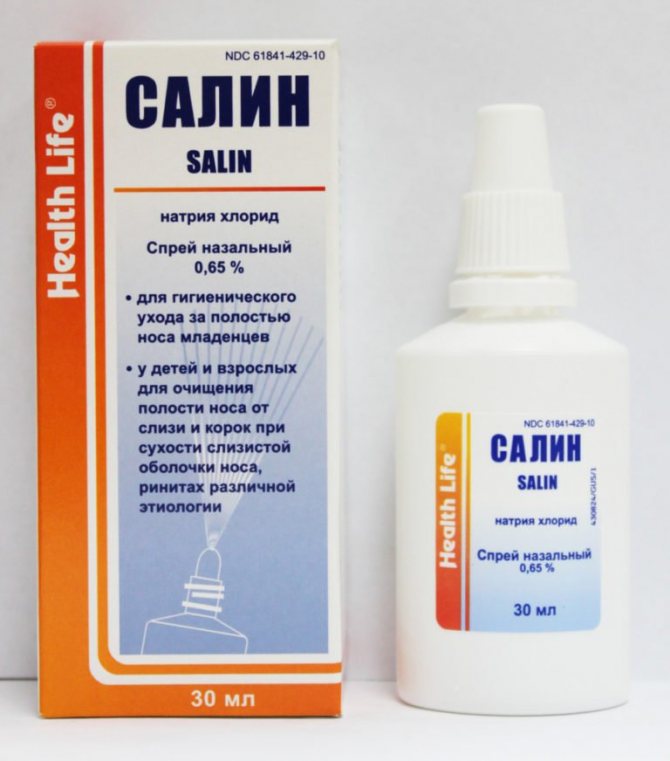
You can cleanse your baby's nasal passages up to 4 times a day. There are other saline solutions on sale for washing children’s noses - analogues of saline solution in a more compact dosage - “Salin”, “Marimer”, “Humer”, “Aquamaris”. They are available in the form of bottles with a dropper nozzle (and then the rinsing procedure requires less preparation) or a spray (but injection under pressure can damage the delicate children's mucous membrane, therefore it is not recommended for children under 7 years old). However, the cost of such drugs is several times higher than that of saline solution, but the principle of action is identical.
Contraindications
The drug is completely safe. Saline solution can be instilled into the nose even for newborn children, pregnant and lactating women. If used correctly, this product does not cause adverse reactions or allergies.
However, sometimes the use of saline solution to rinse the nose is prohibited. Key restrictions on the use of the substance include the following:
- large polyps, tumor formations in the nose;
- a tendency to frequent nosebleeds;
- complex forms of heart failure;
- severe kidney pathologies.
What is the best way to rinse your nose?
The choice of remedy depends on the disease:
- With a runny nose. A saline solution is used, which must be dripped into each nasal passage. The amount of the drug is selected taking into account the age of the baby.
- When stuffy. The child has swelling of the mucous membrane, so after irrigation a vasoconstrictor drug (Nazivin, Nazol) should be instilled.
- With green snot. The color of the mucus indicates the presence of a bacterial infection. In this case, it is better to use antiseptics (after consultation with a pediatrician). Rinsing the nose promotes a speedy recovery for the child.
- For sinusitis. The disease is characterized by stagnation of mucus. Complex treatment is carried out. Irrigations thin and remove snot.
Currently, there is a wide range of preparations for nasal irrigation in the form of drops and sprays. When choosing, you should take into account age, since you cannot rinse the nose of a child under 12 months using a continuous stream under pressure. When injecting liquid, mucus may move from the nose to the inner ear. This is due to the fact that the Eustachian tube in children, connecting the nasal cavity and ear, is much shorter than in adults.
Preference should be given to ready-made solutions, since when preparing the liquid yourself, incomplete dissolution of small particles or a violation of the dosage is possible. This often leads to irritation and burns of the mucous membrane.
Saline and saline solution
Preparations based on sea water (Aqualor, Aqua Maris) are suitable for children from the first months of life. They do not irritate the nasal mucosa, since their composition is similar in salt level to the natural salinity of blood. The products contain useful microelements that promote rapid healing of microcracks, relieving swelling and inflammation. The solutions are suitable for daily use.
Saline solution is also made based on salt. It has a lower cost and is not inferior to expensive analogues in terms of efficiency. Saline solution can be used as a preventive measure during the cold season. It does not include an instillation device, so for irrigation you need to purchase a pipette.
A nasal rinse solution can be prepared at home. To do this, you need to dilute 1 tsp. in 180 ml of boiled water. Pediatricians recommend using a home remedy in extreme cases, because the proportions can be upset, which will lead to irritation and drying out of the mucous membrane.
Herbal decoctions
Before using decoctions of medicinal herbs (for example, chamomile), you should consult your pediatrician and make sure there is no allergic reaction to the plant. To prepare you need:
- pour a glass of boiled water over the grass;
- cook for 3-5 minutes;
- cool the broth;
- strain through fine cheesecloth.
Chamomile flowers, sage, oak bark, St. John's wort and calendula have a healing effect. Decoctions help thin thick mucus and remove it quickly. Chamomile has an antiseptic and anti-inflammatory effect, which has a beneficial effect on the nasal mucosa and speeds up the healing process.
Antiseptic drugs
Known antiseptic drugs used to irrigate the nose and throat:
- Miramistin. It has an antimicrobial effect and is suitable for the treatment of various diseases. Effectively fights fungi.
- Furacilin. To prepare the solution, dissolve 1 tablet in a glass of boiling water and cool. For children under 3 years of age, the solution should be diluted with 100 ml of liquid. If you use a concentrated product, you may get burned.
- Chlorhexidine. The product has a detrimental effect on viruses and bacteria. When using, it is necessary to monitor the dosage, since the drug can cause burning and dryness of the mucous membrane.
- Dioxidine. Before use, you need to thoroughly clean your nasal passages. Has a strong antibacterial effect.
This is interesting: Rules for raising children - let's learn in detail
Pharmaceutical preparations containing sodium chloride
The isotonic solution is sold in bottles or sealed bags. Such containers are completely sterile and sealed with an airtight stopper. The drug is taken into a syringe by puncturing the rubber stopper. Pharmacy options for nasal rinsing are much more convenient. They are available in drop or aerosol format. They have a special sprayer that converts saline solution into an aerosol. The safest and most universal are those products based on sea water.
All pharmaceutical solutions for rinsing the nasal passages are used heated. They are heated in the hand for 30 minutes. The use of sea water-based products moisturizes the mucous membrane, washes out microbes and reduces inflammation. Preparations in spray format are highly effective, but are not used for children under 2 years of age .
Sodium chloride for rinsing the nose, also known as saline solution
What does saline solution look like? Saline solution is an absolutely transparent, sterile isotonic solution of ordinary salt or sodium chloride with a concentration of 0.9%. It is available in the form of bottles, sealed with rubber and aluminum caps, with a volume of:
- 100 ml;
- 200 ml;
- 400 ml.

You can also purchase ampoules with this medication, volume:
- 5 ml;
- 10 ml;
- 20 ml.
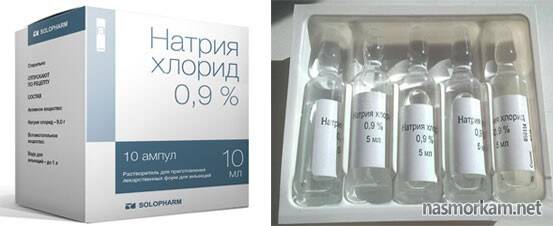
In medicine it is widely used for:
- dilutions of all kinds of drugs produced in the form of powder for injection;
- removing toxins from the blood in case of all kinds of poisoning;
- replenishing fluid deficiency due to dehydration, etc.
It is widely used for washing the eyes, mouth, vagina and, of course, nose, and, therefore, any doubts whether irrigation can be done with saline solution for droppers are not justified.
In addition, it is an analogue of all modern saline solutions, packaged by caring manufacturers in easy-to-use dropper bottles and aerosol cans. There are a lot of such drugs. A pharmacist at any pharmacy will be able to name at least 10 of them. This:
- Marimer;
- Physiometer;
- Aquamaris;
- Humer;
- No-salt;
- Quicks et al.
They differ only in appearance and how much regular saline solution costs, because its price is several times lower than that of ready-made medicines. Therefore, if you don’t want to overpay, and you have the opportunity to spend a few minutes more on the washing procedure, you should confidently choose it.
How to make saline solution for rinsing a child’s nose yourself
Sometimes there is no time to go to the pharmacy, or the need to rinse your nose arose late at night. In this case, a logical question arises regarding how to prepare saline solution for rinsing the nose. To do this you will need the following:
- Boiled water;
- Iodized or sea salt. Regular table salt is not effective enough;
- The container in which the saline solution will be prepared.
To improve the effect, a drop of iodine can be added to the composition. The recommended proportions for adults are a level teaspoon of salt per liter of water. The water must be warm so that the salt dissolves well in it.
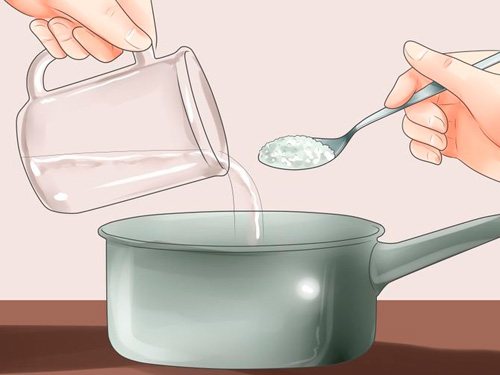
You can also add soda to the mixture at the tip of a knife. It helps soften the nasal mucosa. Maintaining proportions is very important! Otherwise, such a medicine will only cause harm.
For a child, the solution is made less concentrated. In particular, saline solution for rinsing the baby’s nose is made at the rate of a quarter teaspoon of salt per liter of water. For children over a year old, you can add a little less than half a spoon.
The container in which you plan to prepare the saline solution must be washed clean. This directly affects the purity of the solution. There is no talk of sterility here, so the resulting saline solution is used exclusively for rinsing the nose.
Buy or cook
The assortment of any pharmacy always includes saline solution, packaged in glass bottles of 250 and 400 ml. The pharmaceutical preparation is sterile; it is prepared from distilled water and salt without impurities. That is, it is completely safe for newborns.
How to make your own saline solution to rinse your child’s nose at home? To do this, you will need 9 g of table salt (1 teaspoon) and a liter of warm boiled water. The salt is dissolved in water, the resulting solution is filtered and, if necessary, cooled - the temperature of this product for rinsing the nasal cavity should be about 36 degrees.
It should be noted that a self-prepared saline solution is not sterile, and it can be used to treat children over three years old - the product is suitable for rinsing the nose and rinsing the hair. Its shelf life is limited to one day.

When preparing your own saline solution, it is important to maintain the proportions of salt and water as accurately as possible. Insufficient concentration is the cause of discomfort in the child, since the mucous membrane is sensitive to contact with plain water
An excess of salt draws out moisture, causing the mucous membranes to become dry after treatment. Therefore, you need to use a kitchen scale to measure the amount of salt.
The need for nasal rinsing and contraindications
Using saline solution to rinse a child’s nose is advisable in the following cases:
- To moisturize the mucous membrane;
- If it is necessary to eliminate pathogens;
- If mucus has accumulated in the nose;
- In case of inflammation of the nasal mucosa and sinuses in the nasal cavity;
- If the microflora in the nasal cavity is disturbed;
- It is also advisable to rinse the nose with saline solution for sinusitis.
There are no contraindications as such when using sodium chloride. Therefore, saline solution can also be used for preventive purposes. But if a child’s temperature rises or purulent nasal discharge appears, you should stop rinsing and consult a doctor.
When is a rinsing procedure required?
Many pediatricians recommend systematically cleaning the nasal cavity with this product. This is due to several reasons:
- The drier the mucous membrane, the weaker it is against microbial attacks. In infants, the immune system is much weaker; it is not yet fully formed. The nose is one of the places where the thickness of the skin and mucous membrane remains minimal. This means that the risk of infection of the baby is very high.
- Even if the parents do not experience an allergic reaction, the newborn is not immune from this. The product will help clean not only the internal cavity, but will also remove all potential allergens.
- The physiology of the children's nasopharynx is such that up to six months it is difficult for the baby to breathe, because all the airways have not yet been opened. This rinsing helps remove even minor accumulations of mucus.
- And of course, the procedure is prescribed for a runny nose. But you should do it not with a pipette, but with a syringe, in order to remove the mucus plug under a little pressure.
- Such rinses help with rhinitis, sinusitis or inflammation of the adenoids.
You should know that even if saline solution itself is not harmful, this does not mean that it is permissible to use it without consulting a doctor. The fact is that the mother may not notice that the baby has breathing problems not because of a clogged nose, but because he has a deviated nasal septum. Therefore, such points should also be taken into account.
After rinsing the nose with a saline solution, if necessary, the baby is given a drop of medicine. In this case, the effect of the medicine will be more noticeable
Performing the procedure on a child over one year old
You can rinse the nose of a child under 3 years of age as follows. If the baby already knows how to blow his nose, you need to ask him to blow his nose and help him clean the right and left nostril alternately. For babies older than one year, you can drop 2-4 drops of saline solution into the nose to soften dried crusts.
To rinse the nasal passages, you will need to prepare a rubber bulb with a soft tip or a syringe without a needle. The child should bow his head over the sink and turn it to the side so that one nostril is slightly higher than the other. The baby's mouth should be slightly open during the procedure.
It is necessary to slowly, without creating pressure, pour the prepared saline solution into the “upper” nostril with a rubber bulb or syringe. The injected liquid should pour out from the “lower” nostril along with the mucus that has accumulated in the nose. In this way, the right and left nostrils are cleaned alternately. After completing the procedure, you should invite the child to blow his nose well or remove the remaining liquid with an aspirator.
Best video on the topic: instructions for rinsing the nose
To rinse the sinuses, antiseptics, preparations with salt, and herbal compositions are used.
Sodium chloride
This is simple table salt. Also called physiological solution. For showering with it, you can use either a special bulb or a device similar to a teapot with a narrow nose. Five-milliliter (without needles) syringes are also suitable. The saline solution removes inflammation in the nasal canals and kills their pathogens.
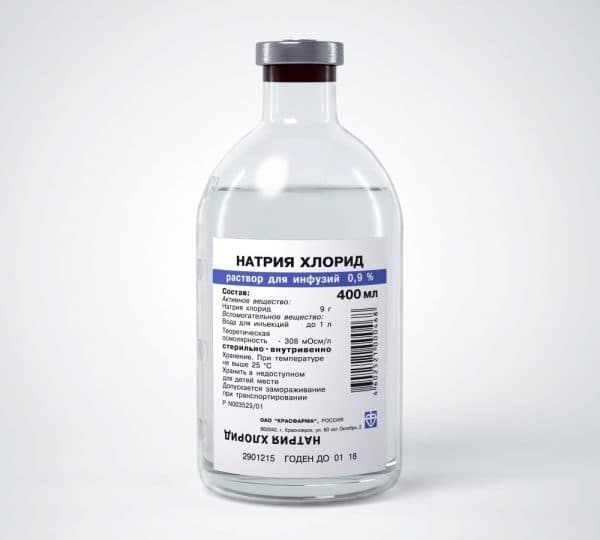
Price from 25 rub.
Dioxidine
Price from 322 rub. A bactericidal agent, like saline solution. It is effective if the disease is caused by bacilli (for example, Pseudomonas aeruginosa), strains of various bacteria that are resistant to other agents, or staphylococci. Dioxidin is also suitable for the development of inflammation in the maxillary sinuses. Before use, you need to pour vasoconstrictor drops into your nose, then rinse. A syringe is suitable for showering with dioxidine.
Malavit
The base is vegetable, but it also contains stone oil, mumiyo, biocomplexes based on copper and silver, resin and tree gum. Removes inflammation in the nose and kills most pathogens. It is effective both for any rhinitis and for inflammation in the maxillary sinuses. For nasal showers, add up to 10 drops to 100 ml of water. A nasal shower is done up to 5 times a day.
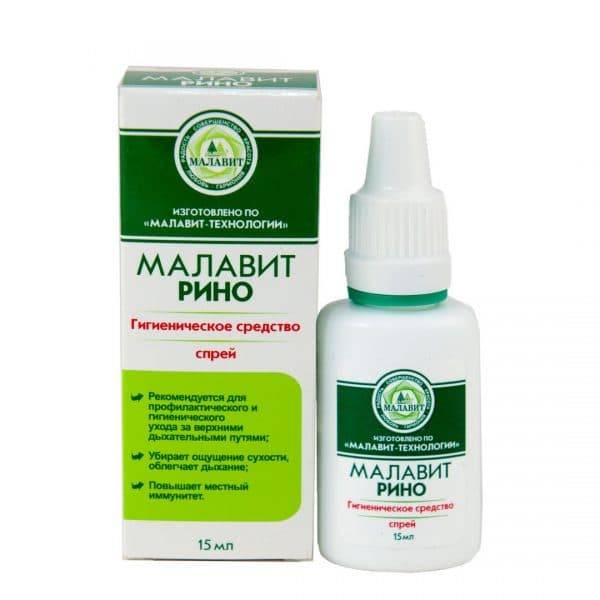
The cost of the drug is from 80 rubles.
Metrogil
The active ingredient is metronidazole. Fights protozoa and anaerobic bacteria. Metrogyl intravenous solution is suitable for showering. For these purposes, a bottle of Dauphine will do.
Iodinol
The price is around 50 rubles. The composition contains potassium iodide in combination with iodine and alcohol. A long-known antiseptic. Effective for tonsillitis, runny nose and otitis. For nasal showers, iodinol is diluted to a light blue color. It can be combined with gargling.
The active ingredient is oxymetazoline hydrochloride. There is a spray for nasal showers, and Afrin is also available in the form of drops. The action is based on the narrowing of blood vessels in the nasal mucosa. Apply 2 times a day. Relieves symptoms of rhinitis, sinusitis and eustachitis.
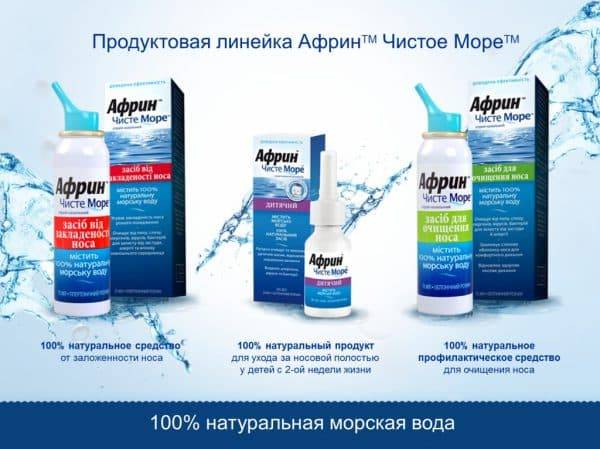
The drug is sold from 65 rubles.
Mestamidin
It combines two strong, but different in action, antibiotics - phenoxethianol and octinedine dihydrochloride. Effective against a large number of microbes and viruses that cause sinusitis and runny nose of various etiologies. Available in spray form. Price from 155 rub.
Refers to synthetic glucocorticoids. Known for its strong anti-inflammatory effect. For nasal douche it is rarely used and in cases where other drugs do not work. Effective for prolonged rhinitis, sinusitis, and swelling. To prepare an antiseptic solution, one ampoule of the product is dissolved in 0.2-0.25 liters of boiled and cooled water. The price of the drug in ampoules is from 215 rubles.
Read how to use Cromohexal spray here.
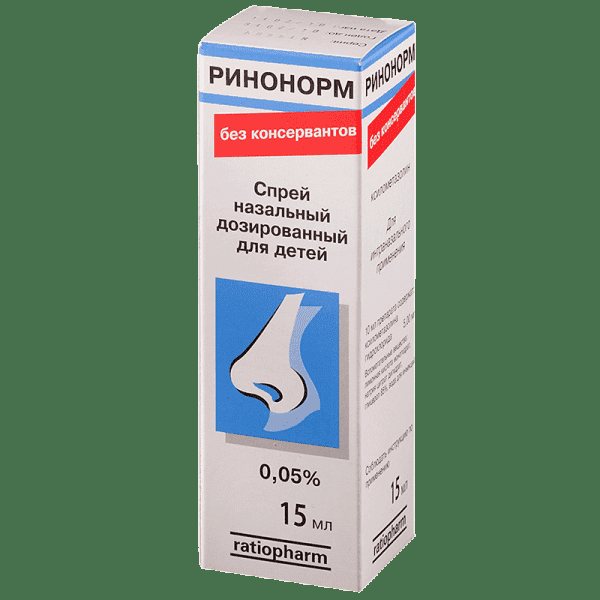
You can purchase the drug for 85 rubles.
Xylitol
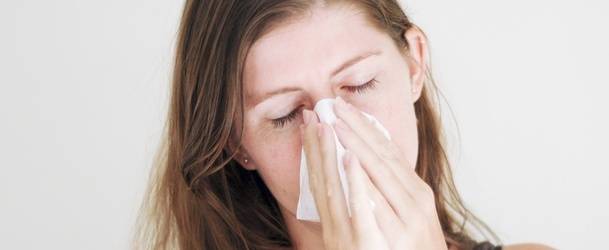
Xlear is a saline nasal spray containing Xylitol. It is injected once every 12 hours. Xylitol stops the activity of bacteria, saving from any etiology of rhinitis and inflammatory ailments of the nasal passages. In addition, xylitol moisturizes the mucous membrane and relieves irritation. Price from 700 rub.
Read about the features of Avamis spray in this article.
All nasal shower sprays with sea salt are divided into two categories: isotonic and hypertonic. In the first, salt is contained in a concentration of up to 0.9%. Effective for allergies and colds, they act gently. Such sprays moisturize well, but they do not relieve swelling. In hypertonic solutions, the salt concentration can be from 1.9% to 2.3. In some sprays the concentration may be higher. Such products not only increase local blood circulation, but also adsorb, relieving swelling.
Features of the procedure for washing with saline solution for newborns and infants
Correct position when instilling saline solution in a newborn
Experienced pediatricians advise mothers to use 0.9 percent sodium chloride to rinse the nasal passages of children from the moment of their birth. In this case, you must be careful, do everything slowly and carefully, so as not to harm the baby.
- Infants have very weak, unformed immunity. They are joined by infection through the respiratory tract, which leads to illness. If you use saline solution and rinse your nose with it, the accumulated microorganisms will disappear.
- In addition to protecting against infections, saline solution can flush out the allergen from the nasal passages. This could be pollen or dust that got into the child’s nose while walking and triggered an allergic attack.
- In infants, not all airways are open until they reach six months. The solution can clear mucus buildup from them. It can also be used for rhinitis, inflammation of the maxillary sinuses and inflammation of the adenoids.
If your baby’s problem with nasal congestion does not go away with prolonged use of saline solution, you should contact your pediatrician with a complaint. Breathing problems can be associated not only with the accumulation of mucus in the respiratory tract, but also due to a deviated nasal septum or other anatomical pathology.
What products to use for rinsing
It is better to rinse the nose of children before going to kindergarten or school in the winter. In addition, the procedure must be repeated upon returning home from crowded places. To cleanse the nasal passages of snot, you can use pharmaceutical preparations and traditional medicine.
It is better to rinse the nose of children before going to kindergarten or school in the winter. In addition, the procedure must be repeated upon returning home from crowded places. To cleanse the nasal passages of snot, you can use pharmaceutical preparations and traditional medicine.
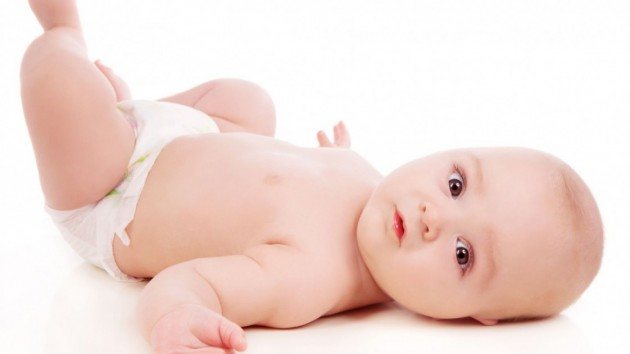
Immediately after birth and during the first year of a baby’s life, many mothers face a huge number of questions and difficulties. One of these difficulties is the safe, correct and effective rinsing of the baby’s nose when there is a runny nose and persistent nasal congestion caused by the accumulation of mucus.
We recommend reading: Nitroglycerin overdose - signs, first aid, treatment, consequences
Inhalations
Such procedures with saline solution are effective both for the treatment of rhinitis and for the prevention of such a disease. To carry them out, a nebulizer is used, into which it is best to fill a sterile pharmaceutical saline solution.
The volume of solution used depends on the age of the baby. For small children, 3-4 ml is enough, and for schoolchildren the dosage can be increased. The procedure is carried out 1-3 times a day, and its duration is from one to five minutes. The baby should inhale the saline solution calmly, and for 1 hour after inhalation you should not feed the child or walk with him.
Why rinse your nose with saline and how often to do it
Rinsing a newborn's nose is useful in many cases. This procedure allows you to:
- Clean the nasal cavity from foreign bodies and street dust accidentally inhaled during breathing;
- Prevent colds and reduce the risk of bacterial infections in the nasal cavity;
- Effectively treat a runny nose - saline solution itself has an antibacterial effect, plus it enhances the effectiveness of drugs for the runny nose, since they come into contact with cleansed mucous membranes;
- Eliminate allergens from the nose (pollen, etc.) when rinsing, due to which children with allergies experience less discomfort and reduce the risk of an allergy attack;
- Moisten the nasal mucosa if the child is in a visit with low humidity levels and experiences discomfort;
- Free your nose from dried crusts that interfere with normal breathing;
- Normalize the microflora of the nasal cavity, reduce mucus production.
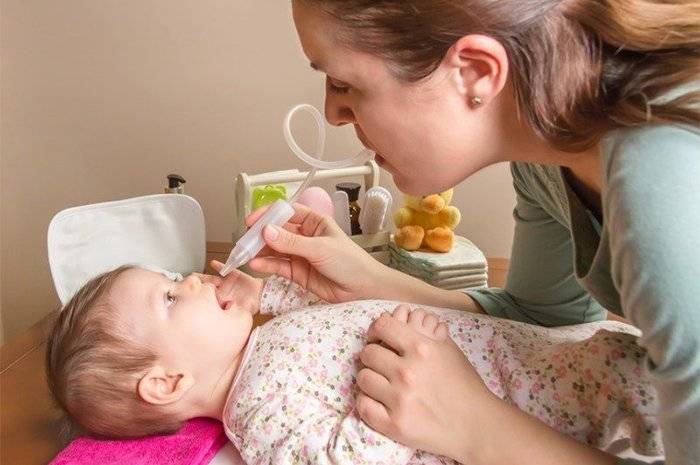
It is very important for a newborn baby to breathe fully through his nose - if he does not have this opportunity, he eats poorly, constantly releasing his chest to inhale through his mouth. If a baby sucks and breathes through his mouth at the same time, he swallows a lot of air.
This provokes regurgitation and burping, which causes serious discomfort to the baby.
For adults and older children there are no restrictions on the use of saline solution - the product can be used as needed. But if we are talking about infants, you should consult your pediatrician before using sodium chloride solution.
It is recommended to drip into the nose or rinse the nasal cavities of a newborn with a solution of sodium chloride in the following cases:
- drying out of mucous membranes, regardless of the reasons;
- formation of dense crusts in the nose;
- vasomotor rhinitis;
- runny nose caused by viruses;
- runny nose due to a cold;
- sinusitis, including purulent;
- allergic manifestations.
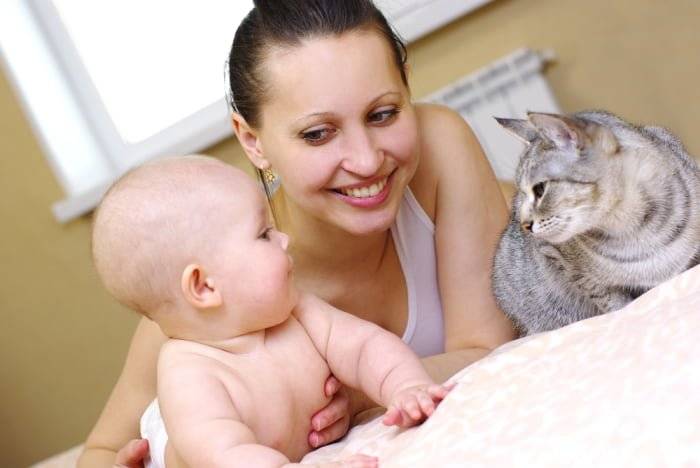
The frequency of using saline solution at home depends on the purpose of its use:
- for prevention – no more than 2 times a week;
- for hygienic care for diseases of the upper respiratory tract, inflammation of the nasal mucosa, allergies, etc. – 2-3 times a day.
Before starting the procedure, it is important to learn how to properly rinse a child’s nose so as not to harm him and cause minimal inconvenience.
conclusions
- Saline solution is a unique and effective means of combating viruses and microbes.
- Wide spectrum of action of the drug.
- It is characterized by low cost.
- Used in the treatment of children, pregnant and lactating women.
- The shelf life depends on the method of “extracting” the liquid from the container or the method of its preparation.
- Do not use if there is a risk of bleeding or swelling of the mucous membrane.
- The number of procedures using the drug depends on the severity of the disease.
Sources
- https://doctos.ru/np/fizrastvor-dlya-promyvaniya-nosa.html
- https://o-krohe.ru/nasmork/fizrastvor/
- https://dokLOR.com/nos/nasmork/lechenie-n/v-domashnih-usloviyah/promyvaniya/sredstva/fizrastvor.html
- https://MedBoli.ru/dyhatelnaya-sistema/lechenie-i-profilaktika/kak-prigotovit-fizrastvor-dlya-promyvaniya-nosa-rebenku-v-domashnih-usloviyah
- https://lovingmother.ru/zdorove/lekarstva/fizrastvor-dlya-promyvaniya-nosa.html
- https://kpoxa.info/uxod-razvitie/promyvat-nos-fizrastvorom-rebenku.html
- https://VseProRebenka.ru/zdorove/preparaty/fizrastvor-dlya-promyvaniya-nosa-novorozhdennomu.html
- https://nos-zdorov.com/procedury/promyvanie-fizrastvorom-detyam
How to properly prepare saline solution to rinse a baby’s nose at home
Saline solution for rinsing the nose of a newborn should be in every mother's medicine cabinet, especially if the house is hot and stuffy. It will help moisturize the mucous membranes, which is necessary to protect against infectious diseases.
If a child gets sick, it is useful for parents to know how to properly rinse their baby’s nose with saline.
Wrong actions can lead to complications, and the baby’s breathing will not only not be restored, but also, for example, otitis media will occur.
Baby
Why is saline solution suitable for rinsing?
A saline solution differs from ordinary water in that it does not affect the cells of the mucous membranes and does not damage the membrane. It is widely used in medicine to dilute various drugs.
It is also administered intravenously to maintain water-salt balance, which is necessary for dehydration.
It has antimicrobial properties, which makes it possible to use it to cleanse wounds; people turn to it for ARVI and runny nose.
Saline solution is isotonic; the concentration of salt in it and in human blood plasma is almost the same. That is why it can be used for medicinal purposes. A sodium chloride solution cannot cause any harm.
Benefits of rinsing your nose with saline solution
Saline solution used to rinse a child's nose has beneficial effects:
- Moisturizes the nasal mucosa, which is important not only during illness, but also during the heating season, when apartments are hot and dry;
- Clears the nasal passages of dust particles, as well as dangerous microorganisms, viruses and bacteria;
- It thins mucous secretions, making them less thick and viscous, allowing them to flow down the throat. As a result, the child swallows them, which does not harm his health, but breathing is restored;
- Swelling of the mucous membrane decreases, inflammation becomes less severe. As a result, breathing through your nose becomes easier and freer.
Advice. In addition to taking care of the mucous membrane, you need to remember about humidifying the room. This brings the moment of recovery closer. Being in a room with dry, stale air has a bad effect on the well-being of not only children, but also adults.
How to cook and breed
Test for enterobiasis - how to test for a child under one year old
For the treatment of infants, especially newborns, it is recommended to purchase saline solution at the pharmacy. It is sterile, so it only brings benefits to the body. The main thing is to preserve it even when using the product. If you need a saline solution urgently, but you can’t go to the store, you can make it at home.
Homemade recipe
To get a solution for rinsing your nose, you need to take boiled water and salt. You will need 1 teaspoon of salt per liter of liquid. If you add more, the concentration will be too high, which will cause irritation of the mucous membrane.
Preparing the solution at home
Note! The solution must be thoroughly placed or shaken so that the product is homogeneous, without sediment. If necessary, you can strain it, this will get rid of any remaining crystals.
It is recommended to store the prepared solution for no more than a day, so it is better to take a smaller amount of water, observing the proportion.
If you keep the product in the refrigerator and do not disturb the created sterility, you can use it for several days. Before rinsing your child’s nose, you need to pour it into a separate container.
You should not draw from a common bottle with a pipette, which is used to carry out the hygienic procedure.
Rinsing the nose of a child under one year old
Eggworm test - how to test for a child under one year old
Before rinsing the nose with saline solution for a child under one year old, you need to calm the baby.
It is recommended to start any procedures when the baby is in a good mood and relaxed. Otherwise, if he struggles and twitches, there is a risk of injury.
The washing procedure looks quite simple, but there are several nuances that need to be taken into account to avoid unpleasant consequences.
How often to wash
You can rinse your child’s nose at least every half hour. The main thing is that the baby does not strongly resist this and does not cry.
If any instillation is accompanied by hysteria, then the effectiveness decreases, because breathing again becomes difficult due to snot that appears during crying.
It is not recommended to remove nasal discharge after rinsing more than three times a day, otherwise you can injure the mucous membrane, which will increase swelling and worsen the baby’s well-being.
Nasal rinsing technique
Step-by-step instructions on how to rinse a baby’s nose with saline:
- Prepare the child by placing him on his back;
- Wipe your nose with a damp swab, removing visible dirt and crusts located on the surface;
- Turn the baby's head so that the nostril that you plan to rinse first is at the top;
- Pour in 3-4 drops of solution, 1-2 is enough for a newborn. The pipette does not need to be inserted inside - if the baby twitches, he can be injured. To make it more comfortable, the baby’s head is tilted back a little;
- Turn the baby over and repeat the procedure from the second nostril;
- After a few minutes, the crusts will soften, the mucous membrane will moisturize, then you can remove the secretions with an aspirator. It is convenient to use a mechanical nozzle pump, the force of which is regulated by parents. One end of the device is inserted into the child’s nostril, the other is in the mother or father’s mouth. They inhale air, and the snot is sucked into a special container. A filter prevents them from getting into the tube and the mouth of adults, which must be cleaned after the procedure and changed periodically.
Removing snot with an aspirator
Note! If a child is seen by a doctor and is prescribed medicinal drops, they should be used after cleansing the nose. Even vasoconstrictors are used after washing. They cannot be dripped often; they are allowed to be used only in extreme cases, if the child cannot breathe, which is why he cannot eat and sleep normally.
You should try to teach your child to blow his nose on his own. This will greatly simplify the procedure and will be an excellent prevention of nasal congestion. If, while washing in the morning and evening, the little one can remove the snot himself, they will not accumulate, which means that there will be nothing to dry out, even if the humidity in the apartment is low.
Features of the procedure for a newborn
Breasts, especially newborns, need to be instilled into the nose; sprays should not be used. They can lead to complications, in particular otitis media.
When they are used, the pressure in the middle ear is disrupted, which often leads to damage to the eardrum.
In addition, along with a stream of medicinal solution, mucous discharge from the nose can enter the ear canal, as well as infection, which will lead to inflammation.
Mom drips on baby's nose
It is also better not to drip into your nose with a syringe. It is not always possible to adjust the pressing force, and the liquid will enter the baby’s nose under great pressure, then there is a risk of harming it. A syringe, naturally with a needle removed in advance, can replace an aspirator if you need to remove liquid secretions that are not very deep.
To soften the crusts that have accumulated in the nose of an infant, you can twist a turk from a cotton pad. For a newborn, it is divided into at least 4 parts and rolled into a cone. Then they are moistened in boiled water or saline solution and carefully screwed into the spout a few millimeters. You need to clean your nostrils one by one. After 5-10 seconds, the cotton wool is taken out, also unscrewing.
Komarovsky's advice
Children's doctor Komarovsky, although he voices a recipe for preparing saline solution at home, calls for buying a sterile product at the pharmacy, because parents often violate the conditions for storing and using the prepared medicinal product.
How to donate blood for sugar in a child under one year old, normal result
Komarovsky emphasizes that it is always necessary to moisturize the nasal passages, even if the baby is not sick. This is only required if comfortable conditions are not maintained at home.
When the temperature in the child’s room is not higher than 20 degrees, the humidity is not lower than 50 percent, and it is constantly ventilated, there is no need for saline solutions. Then the mucous membranes will be moisturized, and additional procedures are not needed. Saline solution will be needed if the child gets really sick.
In this case, the parents’ task is to ensure that the mucous secretions remain transparent and liquid. Periodic rinsing will help with this.
Note! The doctor believes that the aspirator is an excellent invention, which should not be neglected until the child has learned to blow his nose. The main thing is that if parents suck out snot on their own, it is to blow it out, pull the air towards themselves, and not back, otherwise there is a possibility of developing otitis media.
If a child’s runny nose does not go away for more than a month, meanwhile, the home is comfortable, and the parents’ actions are not successful, then you need to visit a doctor. Also, do not postpone a visit to the doctor if the nasal discharge becomes thick, stringy, or changes color, becoming yellow or green.
Child at the doctor
Rinsing the nose with saline is allowed from birth if all recommendations and precautions are followed. The health of the baby depends on the correct manipulations of parents.
You should not put herbal decoctions or medicinal drops purchased without a doctor’s recommendation into your child’s nose, no matter how many useful reviews they receive from friends. Self-medication can be dangerous for the child.
Moreover, you cannot use breast milk - it will serve as an excellent breeding ground for bacteria and will not have any healing effect.
Source: https://kpoxa.info/uxod-razvitie/promyvat-nos-fizrastvorom-rebenku.html
